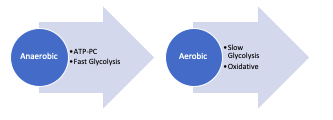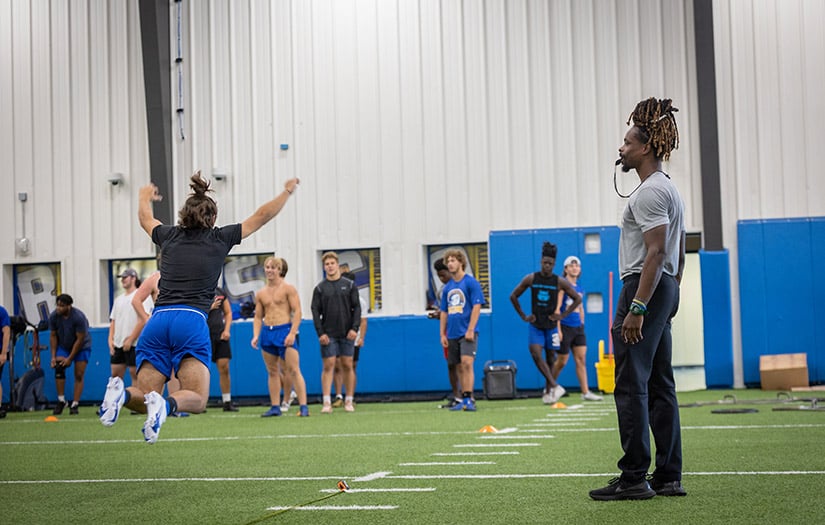There has been an increasing shift from unstructured play to more specialized forms of training for kid athletes. Whether they should participate in strength training, what age they should begin, and what the best training methods are has been an area of interest and concern. While there are still many false beliefs and myths around youth participation in strength training, research has provided evidence supporting programs administered in safe environments under qualified supervision. [1]
A well-designed youth strength training program aims to mitigate risks of athletic injury and improve components of athletic performance (i.e., proprioception, neuromuscular efficiency, and strength). Along with the benefit of physical performance, a youth strength training program also provides youth sports coaches and youth fitness specialists an opportunity to educate youth athletes on nutrition and adequate recovery strategies.
Youth Strength Training – What to Focus On
When deciding what to focus on and where to begin, a thorough needs analysis is the first step. A needs analysis allows a coach to build a profile on their athlete(s). This profile aids the decision-making for both the development and the implementation of a strength training program.
A needs analysis can be categorized into three objectives: develop, educate, and prepare.
Baseline evaluation
A baseline evaluation helps coaches determine what an athlete’s current level of ability is and the areas that can be improved. Data and information gathered from a baseline evaluation can also be used as a means for goal setting and tracking progress.
Components of a baseline evaluation may include:
• Anthropometry
• Movement analysis
• Performance assessments
Anthropometry
Anthropometric measurements are a series of measurements used to assess the composition of the body. They include:
• Height
• Weight
• *Body Mass Index (BMI)Body circumferences (waist, hip, and limbs)
• Skinfold thickness or body fat percentage
*When working with athletes, BMI may not be a valid measurement. An accumulation of lean mass can put an athlete above the recommended weight based on their height but can significantly complement the athlete’s health, athletic performance, and confidence.
Movement analysis
There are known injuries that occur within sports; ACL tears and shoulder girdle, and ankle issues. Although injury is not preventable, the risk of injury can be dramatically minimized through a sound and evidence-based training program. A movement analysis identifies an athlete’s compensations and mechanical deficiencies that may predispose them to some of the previously mentioned sports injuries.
In understanding an athlete’s movement, a coach should also consider the anatomical differences of their male and female athletes. For example, females have a wider pelvis than males, which affects the knee and ankle alignment. [2]
Performance assessments
Tests like the Pro Agility Drill or Vertical Jump help establish an athlete’s baseline level of physical ability. It is essential to understand the demands of the athlete’s sport and position; this will help coaches select valid forms of measurement and determine the path for improving performance. (see Key Performance Indicators)
Nutrition and supplementation
Being knowledgeable on the principles of nutrition and supplementation allows a coach to educate and guide athletes toward decisions that aid their goal for improved health and athletic performance.
Recovery
For an athlete to realize the benefits of a strength training program, recovery from session to session is vital. While exercise has many health-promoting benefits, it is a form of stress. If our body is not given an adequate opportunity to recover from that stress, there can be an adverse and undesired response.
Resources
Outside of training, we ask our athletes to commit to reading, watching, and listening to what can aid their development and performance.
• Read: Books and articles
• Watch:
• Film and videos
• Listen:
• Podcast and audiobooks
Sporting demands + Position demands
Key Performance Indicators (KPI’s)
Individual needs
Although the demands of a particular sport are similar, an effective youth strength training program addresses an athlete's individual needs. Did the athlete express any personal goals? While we are the professionals, the most effective youth strength training program is the one that the athlete is personally invested in.
What age should kids start lifting weights?
Due to the misunderstanding around youth involvement in weight training, it is essential to demystify what weight training is. Proprioception, neuromuscular efficiency, and strength are requisites for most, if not all, sports and are what an effectively designed youth strength training program must consist of.
Proprioception: cumulative sensory input from all mechanoreceptors that sense position and limb movements – awareness.
• Neuromuscular efficiency: ability to produce and reduce force and stabilize the kinetic chain in all three planes of motion – control.
• Strength: the ability of the neuromuscular system to produce internal tension to overcome external force – durability.
After completing a needs analysis, a coach will have a road map for the program's direction and the modalities that can be used to aid an athlete's development and performance. Weight training is not simply barbell training at maximal or near-maximal loads. Introduction to the three components of strength training can begin in early childhood, and progression starts with the individual athlete's interest to continue and then with their psychological and physical maturity.
NOTE: Chronological age is not indicative of maturity. A 7-year-old athlete who has played team sports for two years and has not participated in a structured youth strength training program has a higher training age than a 7 year who has neither sports experience nor training experience. Thus, the athlete with a training age of two may be more athletically adept and better suited to follow instructions. [3]
Workouts for Kid Athletes
With the information gathered from the needs analysis, we can begin developing our youth strength training program.
Program development includes:

Best Strength Exercises for Youth
Determining the most effective exercises will rely on both the maturity and sporting demands of the athlete.
Generally speaking, our athletes should safely and confidently know how to squat, hinge, lunge, pull, and press.
A well-designed youth strength training program should also include:
• Deceleration and proper landing mechanics
• Unilateral and multi-planar movements
• Glute and posterior chain development
Strength and Agility Training for Kid Athletes
What are the major energy systems used during the sport?
There are three components of speed:
• Acceleration
• Maximum Velocity
• Agility
Understanding what major energy systems are at play will determine the proper work to rest ratios.
Nutrition and Recovery for Youth Athletes
A youth strength training program is optimized by an athlete’s ability to recover from session to session, and nutrition plays a massive role in their restoration plan. Having the bioavailability of glycogen from adequate carbohydrate intake fuels performance, especially exercise of short duration like strength and speed training.
Daily readiness questionnaires are an excellent tool for coaches to create a dialogue with their athletes about their nutrition and recovery.
Protein shakes for kid athletes
Through the use of a daily readiness questionnaire, a coach can determine what the use of a protein shake or any supplement for a youth athlete may be. Maybe the athlete is not eating enough, and to gain lean mass, a protein shake can be used to increase daily intake. Perhaps the athlete is overeating, and the lower caloric nature of a shake can serve as a meal replacement for an athlete with a goal of weight loss.
Any supplement prescription or recommendation from a coach should be the third party tested and cleared with parents and physicians.
How Can a Kid Get Stronger Fast?
A kid athlete’s route to a coach may come with no experience, minimal experience, or in many cases, experience from unqualified supervision.
With that said, consider a few things regarding the time of realizing results:
1. Begin with the end in mind.
a. Have a game plan.
b. How is the key performance indicator(s), in this case, strength, being measured, tracked, and developed?
2. Understand that great things take time.
a. Adaptation to a youth strength training program is highly subjective, and depending on the chronological age and training age of the youth athlete, and strength may not yet be the priority.
b. Strength training is only the stimulus. Other factors contribute to the realization of lean mass gain and strength improvement. It is crucial that a youth athlete is also being educated on nutrition and properly recovering from training sessions.
3. Have principles.
a. Although a very important part of our job as Youth Sports Coaches is improving our athletes, we are also a part of a child or adolescent’s development.
b. What can our athletes observe and learn from us that serves them both in their sport and outside of it?
References
[1] AD;, Faigenbaum. “Strength Training for Children and Adolescents.” Clinics in Sports Medicine, U.S. National Library of Medicine, 25 July 2005, pubmed.ncbi.nlm.nih.gov/11019731/.
[2] Robert H. Shmerling, MD. “The Gender Gap in Sports Injuries.” Harvard Health Blog, 23 June 2020, www.health.harvard.edu/blog/the-gender-gap-in-sports-injuries-201512038708.
[3] Myer, Gregory D, et al. “How Young Is ‘Too Young’ to Start Training?” ACSM's Health & Fitness Journal, U.S. National Library of Medicine, Sept. 2013, www.ncbi.nlm.nih.gov/pmc/articles/PMC3793204/.
















